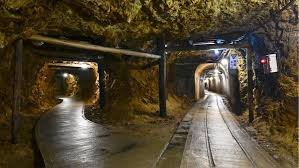Japan’s Sado Gold Mine Gains UNESCO Status
Introduction
The Sado Gold Mine in Japan has officially been designated as a UNESCO World Heritage site. This announcement marks a significant milestone for Japan, highlighting the cultural and historical importance of the mine. The Sado Gold Mine, located on Sado Island in the Niigata Prefecture, has a rich history of gold production dating back to the 17th century.
Historical Significance of Sado Gold Mine
The Sado Gold Mine played a crucial role in Japan’s economic development during the Edo period. Discovered in 1601, the mine became one of the largest gold and silver mines in Japan, contributing significantly to the country’s wealth. The mine’s operations continued until 1989, showcasing its long-term impact on Japan’s industrial growth.
UNESCO World Heritage Designation
Achieving UNESCO World Heritage status is a prestigious recognition that emphasizes the mine’s global significance. The designation process involved rigorous evaluation based on criteria such as cultural, historical, and architectural value. The Sado Gold Mine met these criteria, securing its place on the esteemed list of World Heritage sites.
Impact on Tourism and Local Economy
The UNESCO designation is expected to boost tourism to Sado Island, attracting history enthusiasts, researchers, and tourists from around the world. Increased tourism can lead to economic benefits for the local community, including job creation and business opportunities. The site is anticipated to become a key attraction, promoting cultural exchange and international awareness of Japan’s heritage.
Preservation and Conservation Efforts
With the UNESCO recognition, there will be heightened focus on preserving and conserving the Sado Gold Mine. This involves maintaining the site’s structural integrity, protecting artifacts, and promoting sustainable tourism practices. Efforts will also be made to educate visitors about the mine’s historical and cultural significance.
Conclusion
The inclusion of the Sado Gold Mine in the UNESCO World Heritage list is a testament to its historical, cultural, and economic importance. This recognition not only celebrates Japan’s rich heritage but also ensures the preservation of the site for future generations.

Why This News is Important
Enhancing Cultural Heritage
The designation of the Sado Gold Mine as a UNESCO World Heritage site enhances Japan’s cultural heritage. It acknowledges the mine’s contribution to the country’s history and its role in the global narrative of mining and industrial development.
Economic Boost through Tourism
The recognition is expected to drive tourism to Sado Island, bringing economic benefits to the local community. Increased tourist activity can lead to job creation, improved infrastructure, and greater business opportunities, thereby stimulating the local economy.
International Recognition
Gaining UNESCO status provides international recognition to the Sado Gold Mine, placing it on the global map of significant historical sites. This can foster cultural exchange and understanding, attracting researchers, historians, and tourists from around the world.
Preservation of Historical Sites
The UNESCO designation emphasizes the importance of preserving historical sites. It ensures that the Sado Gold Mine will be protected and maintained, allowing future generations to learn about and appreciate its historical and cultural significance.
Educational Opportunities
The recognition opens up educational opportunities, encouraging academic research and study of the Sado Gold Mine. It provides a valuable resource for historians, archaeologists, and students, contributing to a deeper understanding of Japan’s mining history and heritage.
Historical Context
Edo Period Gold Mining
The Sado Gold Mine was discovered in 1601 during the early Edo period, a time of significant economic growth in Japan. The mine quickly became one of the largest gold producers in the country, contributing to Japan’s wealth and development. The techniques and technologies used in the mine were advanced for their time, reflecting the ingenuity and resourcefulness of the Edo period.
Industrial Development in Japan
The Sado Gold Mine’s operations continued for nearly four centuries, witnessing the evolution of mining techniques and industrial development in Japan. From traditional manual labor to modern machinery, the mine’s history mirrors the broader changes in Japan’s industrial landscape.
Legacy of Sado Island
Sado Island itself has a rich cultural and historical heritage. In addition to the gold mine, the island is known for its traditional performing arts, beautiful landscapes, and historical landmarks. The UNESCO designation of the Sado Gold Mine adds to the island’s cultural significance, attracting attention to its diverse heritage.
Key Takeaways from Japan’s Sado Gold Mine Gains UNESCO Status
| S.No | Key Takeaway |
|---|---|
| 1 | Sado Gold Mine in Japan has been designated as a UNESCO World Heritage site. |
| 2 | The mine has a rich history of gold production dating back to the 17th century. |
| 3 | The UNESCO designation is expected to boost tourism and benefit the local economy. |
| 4 | Preservation and conservation efforts will be heightened to maintain the site’s integrity. |
| 5 | The recognition enhances Japan’s cultural heritage and provides international recognition. |
Important FAQs for Students from this News
Q1: What is the significance of UNESCO World Heritage status for the Sado Gold Mine?
- UNESCO World Heritage status recognizes the cultural and historical importance of the Sado Gold Mine on a global scale. It highlights its exceptional value to humanity.
Q2: How does the UNESCO designation impact tourism on Sado Island?
- The UNESCO designation is expected to increase tourism to Sado Island, benefiting the local economy through job creation and business opportunities.
Q3: What efforts are being made to preserve the Sado Gold Mine?
- Conservation efforts include maintaining the structural integrity of the mine, protecting artifacts, and promoting sustainable tourism practices.
Q4: When was the Sado Gold Mine discovered, and what is its historical significance?
- The mine was discovered in 1601 during the Edo period in Japan. It played a crucial role in Japan’s economic development through its gold and silver production.
Q5: How does the UNESCO recognition contribute to Japan’s cultural heritage?
- The UNESCO recognition enhances Japan’s cultural heritage by preserving and promoting the historical significance of the Sado Gold Mine globally.
Some Important Current Affairs Links


















